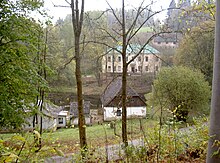Pivoň
| Pivoň | ||||
|---|---|---|---|---|
|
||||
| Basic data | ||||
| State : |
|
|||
| Region : | Plzeňský kraj | |||
| District : | Domažlice | |||
| Municipality : | Mnichov | |||
| Area : | 289.4794 ha | |||
| Geographic location : | 49 ° 29 ' N , 12 ° 44' E | |||
| Height: | 530 m nm | |||
| Residents : | 53 (2013) | |||
| Postal code : | 345 22 | |||
| License plate : | P | |||
| traffic | ||||
| Street: | Mnichov - Závist | |||
Pivoň ( German Stockau ) is a west Bohemian village and part of the municipality Mnichov in Okres Domažlice in the Czech Republic .
geography
Pivoň lies in a basin formed by a 633 meter high ridge in the south-east, Starý Herštejn in the south-west and the 869-meter-high Lysáberg in the north-west. The Pivoňka rises about 3 kilometers further southwest on the slopes of the Starý Herštejn, then flows through Pivoň, Mnichov, Poběžovice, Zámělíč and flows west of Meclov into the Černý potok, which flows into the Radbuza at Horšovský Týn . The basin opens to the east in the direction of Mnichov and Poběžovice . The road coming from Poběžovice via Mnichov leads up in narrow, steep bends to the Vranovské Sedlo (German: Frohnauer Pass) and behind the pass steeply down into the valley from Nemanice to Höll in Bavaria . This road is only passable from late spring to autumn. As soon as the first frosts set in, the water flowing down from the slopes of the surrounding mountains forms a thick, mirror-smooth ice surface that does not thaw until late in spring and makes driving on the road impossible and life-threatening.
history
Numerous finds of stone, copper and bronze tools as well as Celtic silver coins - so-called rainbow bowls - bear witness to the very early settlement of this place.
Some sources say that Pivoň was founded in 932 by Bavarian hermits. In the floor of the church in Valtířov (German: Waltersggrün) a metal plaque was found on which Emperor Heinrich III. with the year 1041 is recorded as the founder of Pivoň. Pivoň was first mentioned in writing in 1260.
In 1789 the village of Pivoň had 24 house numbers and in 1839 43 houses with 391 inhabitants, the Church of the Annunciation, a school, an economic office, a farm, a forester's apartment, a brewery, a liquor house, a potash mill, a mill with a board saw and an inn. Pivoň became a popular summer resort. In addition to the main income from tourism, trout was bred in 6 ponds, which were also delivered to the other seaside resorts.
In 1785, Emperor Joseph II abolished the Pivoň Monastery . It was addressed to the state advocate Dr. Stöhr, whose sons resold it to Count Thun . This proposed it to the rule Ronsperg, which from 1864 belonged to the noble Coudenhove-Kalergi family. The Coudenhove-Kalergi used the monastery buildings as a castle. The monastery church became the village church of Pivoň.
After the Munich Agreement , Stockau was added to the German Reich and until 1945 belonged to the Bischofteinitz district .
In 1945/46 the German residents were expelled.
After a fire in 1953, the church remained in ruins.
Today (2013) efforts are being made to rebuild the church and the former monastery.
Culture and sights
On the northwestern edge of the village of Pivoň are the extensive buildings of the Pivoň monastery, which are being restored.
Personalities
- Ferdinand Woldrzich von Ehrenfreund (1737–1800), lawyer, professor and rector of the University of Prague
literature
- Franz Liebl, Heimatkreis Bischofteinitz (Ed.): Our Heimatkreis Bischofteinitz. Brönner & Daentler, Eichstätt 1967.
Web links
Individual evidence
- ↑ http://www.uir.cz/katastralni-uzemi/697478/Pivon
- ↑ cz: Pivoň
- ↑ Český les jih Turistická mapa. VKU akciová spoločnost´, Harmanec 2004
- ↑ a b Josef Bernklau, Franz Schröpfer, Heinrich Cenefels, Franz Spaderns: Stockau. In: Franz Liebl, Heimatkreis Bischofteinitz (Hrsg.): Our Heimatkreis Bischofteinitz. Brönner & Daentler, Eichstätt 1967, pp. 272-276.
- ↑ a b http://www.vyletnik.cz/mistopisny-rejstrik/zapadni-cechy/chodsko/2864-pivon/


